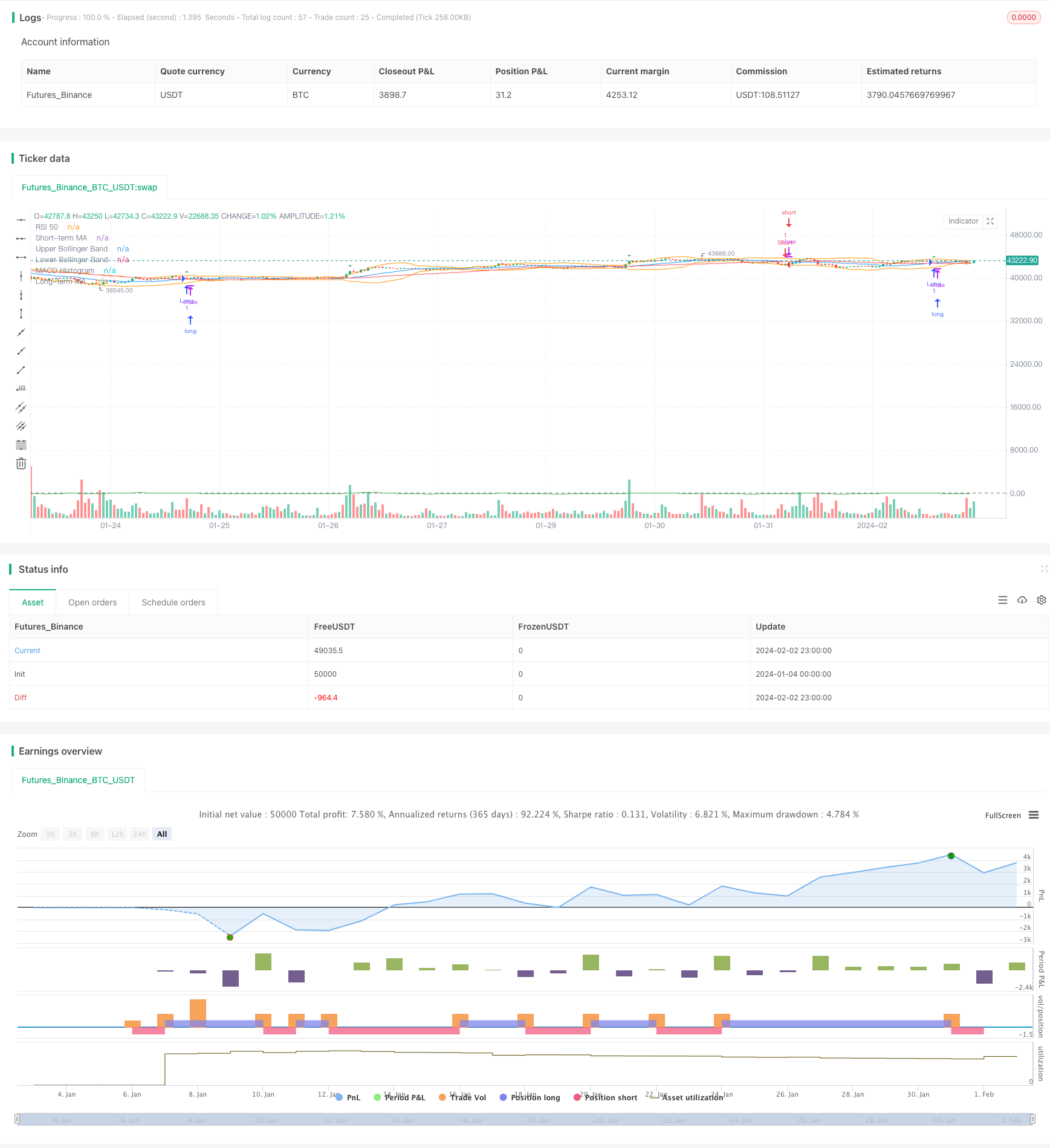Name
动量震荡跨均线交易策略Swing-Trading-Strategy-Based-on-Momentum
Author
ChaoZhang
Strategy Description
动量震荡跨均线交易策略(Swing Trading Strategy Based on Momentum, Oscillation and Moving Average Crossover)是一个利用动量指标、震荡指标和移动平均线的交叉进行买卖信号的策略。它可以用于商品、外汇等市场的日内和日间交易。
该策略同时使用了移动平均线、相对强弱指标(RSI)、MACD和布林带这四个技术指标来识别买入和卖出信号。具体逻辑是:
当短期移动平均线上穿长期移动平均线,并且RSI大于50时,做多;当短期移动平均线下穿长期移动平均线,并且RSI小于50时,做空。
这样的组合可以利用均线的黄金交叉和死亡交叉来判断趋势,同时加入RSI避免趋势逆转的风险。MACD的作用是确定买卖点,布林带则设置了止损位。
该策略最大的优势是指标组合得当,可以有效利用趋势指标和震荡指标的互补性。具体来说:
- 移动平均线判断主要趋势方向和买卖信号点
- RSI用来避免趋势反转的风险
- MACD辅助确定具体的入场点位
- 布林带设置止损位
通过这种组合,可以充分发挥各个指标的优势,同时相互补足不足。
该策略的主要风险有:
- 趋势反转风险。当市场快速反转时,移动平均线和RSI无法及时给出信号,可能导致损失加大。
- 震荡行情的虚假信号。当市场长期震荡时,移动平均线和RSI会频繁给出买卖信号,很容易被套住。
- 参数设置不当。如果参数设置不当,过滤效果会很差,容易产生错误信号。
为了控制这些风险,可以通过优化参数、设置止损止盈、合理控制仓位等方法进行管理。
该策略可以从以下几个方面进行优化:
- 测试不同市场及不同周期参数组合,找到最佳参数。
- 增加波动率指标,可以更好地处理震荡行情。
- 增加交易量指标过滤信号,避免虚假突破。
- 结合深度学习算法实时优化参数,让系统更聪明。
- 优化止损止盈逻辑,让盈利更好、亏损更小。
动量震荡跨均线交易策略利用趋势指标和震荡指标的优势互补性识别买卖信号,在参数优化和风险管理到位的情况,可以获得良好的效果。该策略可以进一步优化指标参数、止损逻辑等方面,从而获得更出色的表现。
||
The Swing Trading Strategy Based on Momentum, Oscillation and Moving Average Crossover is a strategy that uses momentum indicators, oscillators and moving average crossovers to generate buy and sell signals. It can be used for intraday and swing trading in commodities, forex and other markets.
The strategy utilizes four technical indicators - moving averages, Relative Strength Index (RSI), MACD and Bollinger Bands - to identify entry and exit signals. Specifically:
Go long when the short-term moving average crosses above the long-term moving average, and RSI is greater than 50; Go short when the short-term moving average crosses below the long-term moving average, and RSI is less than 50.
This combination takes advantage of golden crosses and death crosses of moving averages to determine the trend, while adding RSI to avoid the risk of trend reversal. MACD's role is to determine specific entry points, and Bollinger Bands set the stop loss levels.
The biggest advantage of this strategy is that the combination of indicators is appropriate to effectively utilize the complementary nature of trend and oscillation indicators. Specifically:
- Moving averages determine the main trend direction and trading signal points
- RSI helps avoid the risk of trend reversal
- MACD assists in determining specific entry points
- Bollinger Bands set stop loss levels
Through this combination, the advantages of each indicator can be fully utilized while complementing each other's deficiencies.
The main risks of this strategy are:
- Trend reversal risk. When the market reverses rapidly, moving averages and RSI cannot give timely signals, which may lead to greater losses.
- False signals in range-bound markets. When the market oscillates for a long time, moving averages and RSI will frequently generate buy and sell signals, making it easy to be trapped.
- Inappropriate parameter settings. If the parameters are not set appropriately, the filtering effect will be poor and wrong signals are prone to occur.
To control these risks, methods like parameter optimization, setting stop loss/take profit, reasonably controlling position size can be adopted.
The strategy can be optimized in the following aspects:
- Test different market and time frame parameter combinations to find the optimal parameters.
- Add volatility indicators to better deal with oscillating markets.
- Add trading volume indicators to filter out false breakouts.
- Optimize parameters in real time with deep learning algorithms to make the system smarter.
- Optimize stop loss/take profit logic for better profitability and smaller losses.
The Swing Trading Strategy Based on Momentum, Oscillation and Moving Average Crossover identifies trading signals by utilizing the complementary advantages of trend and oscillator indicators. With proper parameter optimization and risk management, it can achieve good performance. The strategy can be further improved by optimizing parameters, stop loss logic etc. for even better results.
[/trans]
Strategy Arguments
| Argument | Default | Description |
|---|---|---|
| v_input_1 | 20 | Short-term MA |
| v_input_2 | 50 | Long-term MA |
| v_input_3 | 14 | RSI Length |
| v_input_4 | 12 | MACD Short |
| v_input_5 | 26 | MACD Long |
| v_input_6 | 9 | MACD Signal |
| v_input_7 | 20 | Bollinger Bands Length |
| v_input_8 | 2 | Bollinger Bands Multiplier |
Source (PineScript)
//@version=5
strategy("Swing Trading Strategy", overlay=true)
// Input for moving averages
shortMA = input(20, title="Short-term MA")
longMA = input(50, title="Long-term MA")
// Input for RSI
rsiLength = input(14, title="RSI Length")
// Input for MACD
macdShort = input(12, title="MACD Short")
macdLong = input(26, title="MACD Long")
macdSignal = input(9, title="MACD Signal")
// Input for Bollinger Bands
bbLength = input(20, title="Bollinger Bands Length")
bbMultiplier = input(2, title="Bollinger Bands Multiplier")
// Calculate moving averages
shortTermMA = ta.sma(close, shortMA)
longTermMA = ta.sma(close, longMA)
// Calculate RSI
rsiValue = ta.rsi(close, rsiLength)
// Calculate MACD
[macdLine, signalLine, _] = ta.macd(close, macdShort, macdLong, macdSignal)
// Calculate Bollinger Bands
basis = ta.sma(close, bbLength)
upperBand = basis + bbMultiplier * ta.stdev(close, bbLength)
lowerBand = basis - bbMultiplier * ta.stdev(close, bbLength)
// Plot moving averages
plot(shortTermMA, color=color.blue, title="Short-term MA")
plot(longTermMA, color=color.red, title="Long-term MA")
// Plot RSI
hline(50, "RSI 50", color=color.gray)
// Plot MACD
plot(macdLine - signalLine, color=color.green, title="MACD Histogram")
// Plot Bollinger Bands
plot(upperBand, color=color.orange, title="Upper Bollinger Band")
plot(lowerBand, color=color.orange, title="Lower Bollinger Band")
// Strategy conditions
longCondition = ta.crossover(shortTermMA, longTermMA) and rsiValue > 50
shortCondition = ta.crossunder(shortTermMA, longTermMA) and rsiValue < 50
// Execute trades
strategy.entry("Long", strategy.long, when=longCondition)
strategy.entry("Short", strategy.short, when=shortCondition)
// Plot trade signals on the chart
plotshape(series=longCondition, title="Long Signal", color=color.green, style=shape.triangleup, size=size.small)
plotshape(series=shortCondition, title="Short Signal", color=color.red, style=shape.triangledown, size=size.small)
Detail
https://www.fmz.com/strategy/440965
Last Modified
2024-02-04 10:59:36
